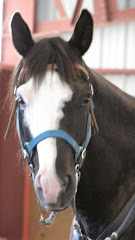Yesterday while riding, I was able to have very relaxed shoulders. Normally, I think I ride relaxed, but when I think about it, in the past my shoulders used to be up or tight or tense. Without me even realizing it, I rode with tension in the neck and shoulders. Many of us ride like that. I thought I rode relaxed until the Centered Riding and Alexander Technique instructors taught me to drop my shoulders. When I rode Shaggy in the field, my shoulders were down. My arms were moving freer. Even when I trotted and post, my shoulders stayed down. It was a great feeling to think about it while I was riding and to realize that my shoulders were relaxed.
Another Centered Riding tip that I was visualizing was that of Stubby Legs. This concept is a little harder for me to analyze and figure out. It became one that I could understand as I rode yesterday, and I felt what my legs were doing. Granted, my 2 horses are a little heavy, making their barrels a little rounder. My thighs did lay on the sides of the horse easier. While maintaining a grounded feeling in my feet, I rode with light contact with my thighs, allowing my thighs to move with the motion of the horse. In the past, I think I stayed grounded in my seat, and my legs hung relaxed, but were not active. Now, I’m maintaining a light contact, and not only moving my seat and hands as the horse moves (at the walk and canter, only elbows at the trot), my thighs are moving with the horse’s motion. And I’m feeling it today, after 2 very active riding days.
I had just read an article in the Centered Riding Newsletter before going out to ride. “When Sally Swift taught us the Following Seat, she also talked about the Following Hand. We should allow the reins to draw our hands forward. Our elbows straighten and bend to maintain consistent contact on the reins. A rider’s hands stay with the horse’s mouth. At the canter, the hands and seat follow the horse’s head and body forward during the 3 beats as the horse’s legs move and land again. The rider’s hip joints open and the elbows open. The both bend again during the suspension phase. The Following Hand is actually the following elbow!!!”
This is one of those “light bulb moments”. Even though I knew this, I finally “got it” yesterday while riding Duke. He does not like a unforgiving grip on the reins. He does not want to be “held” in a frame. He was all over the place, high and low, with his neck and head, searching for that place of comfort. I know that. And with this article in my head, something finally clicked. I don’t have very much formal dressage training, just traditional horsemanship training where you don’t move. Now, over the last 2 ½ years, I have freed up my body to allow the joints to move. Finding correct posture and balance and letting go of tension that first year helped. Learning to allow my shoulders to move last year helped. But all the key pieces fell into place as I rode Duke yesterday.
Duke has only been ridden a few times in the last few years. He was my farm stud and after his first 4 years of training and the show pen, he has sat for the last 10 years with minimal rides. All the training is still there. Yesterday he told me he needs a lighter hold. Yesterday, I finally understood exactly what that was and gave it to him. Like my 3 year old grandson says while watching on of his movies, Incredibles, Lightttttt Bulbbbbb.
That light bulb was shining brighter as I kept a light constant contact on the reins, moving my arms, allowing the elbow to have more action. The difference is subtle, as I was already following the walk and canter with my hands. The impact was huge, as I allowed the elbows to do the following, and my hands were just there. No tension in my body. Duke settled down and quit searching for that spot. I need more practice during his huge, deep canter, but what a difference.
I also realize now why the CR instructors say I lean back at the lope. (and like everyone, I thought I was correct until shown the correct way. I felt like I was leaning forward when I am balanced. After 2 years, that feels correct now). But during Duke’s canter, his momentum kept throwing me back! I was leaning back. I was behind his motion, and I need to correct myself. I went back down to the extended trot and 2 pointed. Then I cantered, keeping that forward feeling in my body. The balance is better. Wow, 2nd light bulb moment was to understand why I learned to do something the way I used to be doing it. My body had responded to the horse’s motion. What my body responded to was momentum, but then I didn’t re-correct myself and go back to balance. I learned to ride there, thinking it was correct. Now, I know where balance is, and I need to remember to keep balancing myself as I ride his deep canter.
What a fun guy Duke is to ride. Wow, I can’t wait to take dressage lessons and ride in my next CR clinic with him. We are on our way of understanding and learning the next layer of riding skills.
I will talk more about Duke soon, I promise. His story is coming. Part of it… he will be 15 this year!









No comments:
Post a Comment